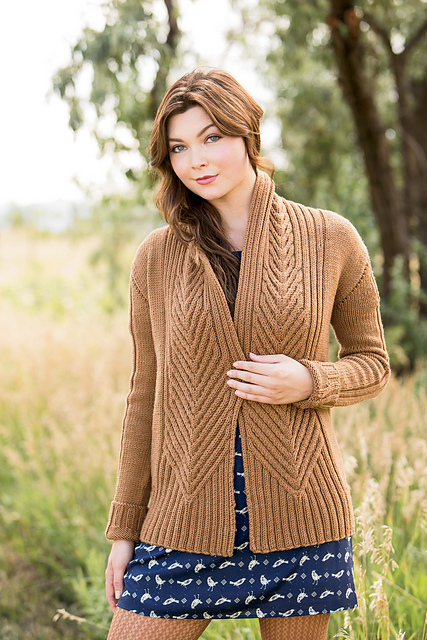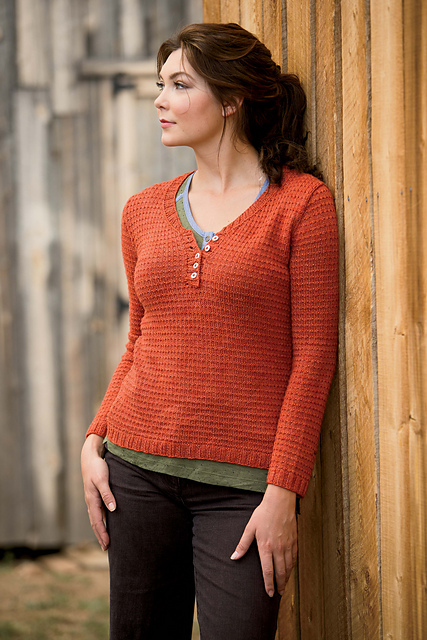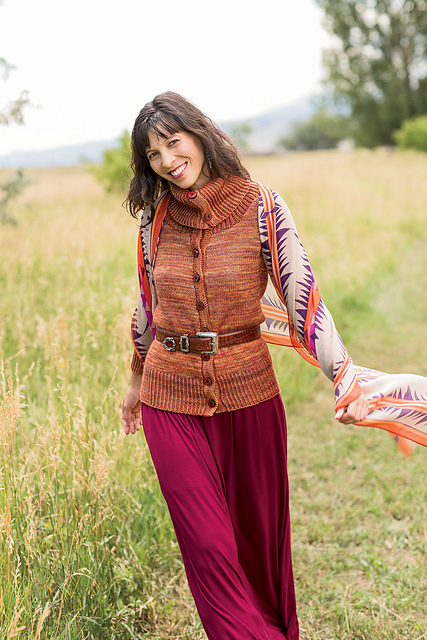This Winter 2014 issue of Interweave Knits is the first for which the new editor, Lisa Shroyer, owned the entire process, from submitting the call for designs, to project selection, to photography, to layout, and all the way to publication. And, it shows. As a collection, I think this is the most wearable I've seen from IK for a very long time. Of course, it still have too many crew neck pullovers for my taste, but at least the ones presented are modern interpretations of classic knits. And, the skinny girls need sweater options, too.

I am going to begin with what I think is the standout of the issue, L'Acadie Cardigan designed by Bristol Ivy. To me, this should have been the cover design. I suspect that it is not because the color is underwhelming. (The orange Henley on the cover is much more eye-catching.)
I love how the design gets more interesting the longer you look at it. The chevron rib pattern is actually cabled down the center. And, it narrows as it moves up to the shoulder, with increasing numbers of vertical ribs as the transition to the stockinette stitch. The combination of vertical and diagonal lines, as well as the very strong vertical line created by the center front opening. While there is a lot of texture, and a larger stitch gauge, that is balanced by the stockinette stitch background.
 What doesn't thrill me is the modified drop sleeve. It is creating a line which cuts across the upper arm. This is not a design detail for those of us with chubby upper arms. My solution would be to substitute a set-in sleeve, as this would not appear to impact the stitch patterning. (Of course I could never knit a sweater pattern as written . . . .)
What doesn't thrill me is the modified drop sleeve. It is creating a line which cuts across the upper arm. This is not a design detail for those of us with chubby upper arms. My solution would be to substitute a set-in sleeve, as this would not appear to impact the stitch patterning. (Of course I could never knit a sweater pattern as written . . . .) The State Fair Cardigan by Heather Zoppetti (shown in purple at right) is another highly textured cardigan. The cable are in very high relief, so this is one to be careful of if you are large busted. But, as in the L'Acadie Cardigan, it has very strong vertical lines accented with the diagonal lines of the stitch pattern.
The State Fair Cardigan by Heather Zoppetti (shown in purple at right) is another highly textured cardigan. The cable are in very high relief, so this is one to be careful of if you are large busted. But, as in the L'Acadie Cardigan, it has very strong vertical lines accented with the diagonal lines of the stitch pattern.
Another design with strong verticals and interesting stitch patterning is the Cerrito Caridgan by Faine Goberstein (shown in beige at left). It's a combination of the vertical cable and diagonal herringbone stitches. The longer length is good for camouflaging wider hips and thighs.
Cynthia's Cardigan by Andrea Sanchez (shown at right in variegated orange) is a good design for ladies who carry their weight through the hips and thighs because the volume of the collar provides a visual balance. (But don't wear this sweater with the collar buttoned up unless you have the long neck of the model. On a shorter neck the collar will appear to swallow your head!) When worn open, the collar creates a strong shoulder line, which also provides balance. The dk weight gauge is not so bulky as to add visual weight.

 This issue also features two Henley designs. A Henley has a center front opening that provides a nice vertical element, but it stops mid-chest. This means that it doesn't have a full vertical impact of a cardigan, and it is harder to get on and off since it's still a pullover. But, they are an interesting variation to the wardrobe. Of the two, I prefer the Manicouagan Pullover by Alex Capshaw-Taylor (shown in gray) because it has a longer Henley opening, and it also has vertical stitch patterning. But, if it were me, I'd just extend the placket and make it a true cardigan.
This issue also features two Henley designs. A Henley has a center front opening that provides a nice vertical element, but it stops mid-chest. This means that it doesn't have a full vertical impact of a cardigan, and it is harder to get on and off since it's still a pullover. But, they are an interesting variation to the wardrobe. Of the two, I prefer the Manicouagan Pullover by Alex Capshaw-Taylor (shown in gray) because it has a longer Henley opening, and it also has vertical stitch patterning. But, if it were me, I'd just extend the placket and make it a true cardigan.
Overall, I would say that this is an outstanding issue of IK, and I am looking forward to seeing more of what Lisa's leaderships brings to knitting.





















